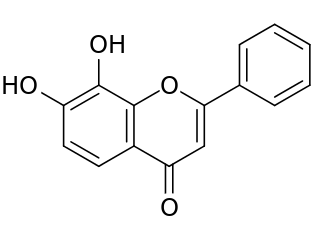Related Research Articles

Streptomyces is the largest genus of Actinobacteria and the type genus of the family Streptomycetaceae. Over 500 species of Streptomyces bacteria have been described. As with the other Actinobacteria, streptomycetes are gram-positive, and have genomes with high GC content. Found predominantly in soil and decaying vegetation, most streptomycetes produce spores, and are noted for their distinct "earthy" odor that results from production of a volatile metabolite, geosmin.

An artificial enzyme is a synthetic, organic molecule or ion that recreates some function of an enzyme. The area promises to deliver catalysis at rates and selectivity observed in many enzymes.

Serine/threonine-protein kinase PAK 6 is an enzyme that in humans is encoded by the PAK6 gene.
In molecular biology mir-367 microRNA is a short RNA molecule. MicroRNAs function to regulate the expression levels of other genes by several mechanisms.
23S rRNA (adenosine1067-2'-O)-methyltransferase is an enzyme with systematic name S-adenosyl-L-methionine:23S rRNA (adenosine1067-2'-O)-methyltransferase. This enzyme catalyses the following chemical reaction

Tropoflavin, also known as 7,8-dihydroxyflavone, is a naturally occurring flavone found in Godmania aesculifolia, Tridax procumbens, and primula tree leaves. It has been found to act as a potent and selective small-molecule agonist of the tropomyosin receptor kinase B (TrkB), the main signaling receptor of the neurotrophin brain-derived neurotrophic factor (BDNF). Tropoflavin is both orally bioavailable and able to penetrate the blood–brain barrier. A prodrug of tropoflavin with greatly improved potency and pharmacokinetics, R13, is under development for the treatment of Alzheimer's disease.

Nosiheptide is a thiopeptide antibiotic produced by the bacterium Streptomyces actuosus.
Streptomyces cacaoi is a bacterium species from the genus of Streptomyces. Streptomyces cacaoi produces polyoxine.
Streptomyces canus is a bacterium species from the genus of Streptomyces which has been isolated from soil in the US. Streptomyces canus produces resistomycin, tetracenomycin D, amphomycin, aspartocin D and aspartocin E.
Streptomyces cavourensis is a bacterium species from the genus of Streptomyces which has been isolated from soil in Italy. Streptomyces cavourensis produces flavensomycin.
Streptomyces diastaticus is an alkaliphilic and thermophilic bacterium species from the genus of Streptomyces. Streptomyces diastaticus produces oligomycin A, oligomycin C, rimocidin and the leukotriene-A4 hydrolase-inhibitor 8(S)-amino-2(R)-methyl-7-oxononanoic acid. Streptomyces diastaticus also produces gougerotin and the antibiotic ruticin.
Streptomyces flavoviridis is a bacterium species from the genus of Streptomyces which has been isolated from soil. Streptomyces flavoviridis produces phleomycin and zorbamycin.
Streptomyces graminearus is a bacterium species from the genus of Streptomyces. Streptomyces graminearus produces the antibiotic gougerotin.
Streptomyces griseoluteus is a bacterium species from the genus of Streptomyces which has been isolated from soil in Tokyo in Japan. Streptomyces griseoluteus produces griseoluteic acid, griseolutein A and griseolutein B.
Streptomyces jiujiangensis is a bacterium species from the genus of Streptomyces which has been isolated from rhizosphere soil from a pine tree from the Mount Lu in the Jiangxi province in China. Streptomyces jiujiangensis produces antialgal compounds.
Streptomyces microflavus is a bacterium species from the genus of Streptomyces which has been isolated from soil. Streptomyces microflavus produces nemadectin, fattiviracin A1, milbemycin and deoxyuridines. Streptomyces microflavus also produces the ionophore valinomycin. Streptomyces microflavus is also known to cause potato common scab disease in Korea.
Streptomyces virginiae is a bacterium species from the genus of Streptomyces which has been isolated from soil. Streptomyces virginiae produces actithiazic acid, virginiamycins and cycloserine. Streptomyces virginiae also produces monensin A, monensin B, monensin C, monensin D, actithiazic acid.

Dishevelled binding antagonist of beta catenin 2 is a protein that in humans is encoded by the DACT2 gene.

C-1027 or Lidamycin is an antitumor antibiotic consisting of a complex of an enediyne chromophore and an apoprotein. It shows antibiotic activity against most Gram-positive bacteria. It is one of the most potent cytotoxic molecules known, due to its induction of a higher ratio of DNA double-strand breaks than single-strand breaks.
Kang Zhang is a Chinese-American ophthalmologist specializing in ophthalmic genetics and aging processes in the eye. He is currently a Professor of the Faculty of Medicine at Macau University of Science and Technology. He was previously a Professor of Ophthalmology and the Founding Director of the Institute for Genomic Medicine at the University of California, San Diego. Zhang is particularly known for his work on lanosterol, stem cell research, gene editing, and artificial intelligence.
References
- 1 2 UniProt
- ↑ Benazet, F; Cartier, M; Florent, J; Godard, C; Jung, G; Lunel, J; Mancy, D; Pascal, C; Renaut, J; Tarridec, P; Theilleux, J; Tissier, R; Dubost, M; Ninet, L (15 April 1980). "Nosiheptide, a sulfur-containing peptide antibiotic isolated from Streptomyces actuosus 40037". Experientia. 36 (4): 414–6. doi:10.1007/bf01975121. PMID 7379912. S2CID 19252290.
- ↑ Ōmura, Satoshi, ed. (1992). The Search for Bioactive Compounds from Microorganisms. New York, NY: Springer New York. ISBN 1-4612-4412-9.